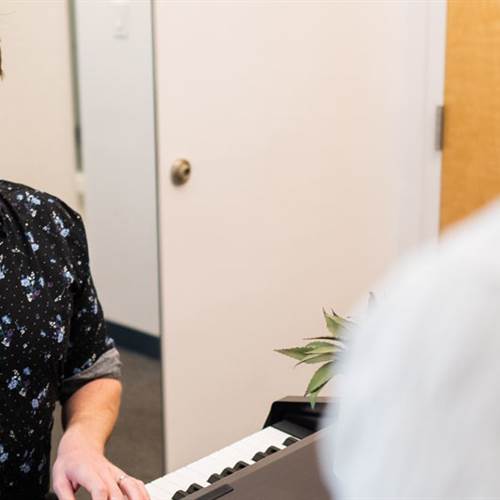
Practicing Singing in New York City: A Practical Guide
Posted Saturday, December 7th 2024 by Bryan Chan
In this article, Bryan offers practical solutions to students struggling to find a private and safe space to practice singing in New York City.
One of the most common questions I get asked by my in-person students is: how do I practice singing in New York City? In an expensive city like this (where most residents live with roommates) students often find it difficult to find a private and safe space for them to practice without affecting others. Even if they live alone, many students work long hours during weekdays and are only home during the apartments’ quiet hours. In this practical guide, I will offer solutions to minimize noise pollution if you want to practice at home and other practice alternatives for students when practicing at home is not an option.
Please note that this article is not sponsored. NYVC is not affiliated with any of the products listed in the article. Any products recommended in this article are products I find useful for my students from experience.
So you want to practice at home…
Here are a few solutions to consider to reduce noise pollution:
For Warm-ups: SOVT exercises
SOVT stands for Semi-Occluded Vocal Tract. Do not be intimidated by this acronym and term! If you have taken any voice lessons, you have probably done some form of SOVT exercises when you warm up and build vocal technique. In layman's terms, SOVT exercises are any straw-like non-vowel vocal exercises that have an emphasis on breath regulation and efficient use of vocal cords. Here are some of my favorite ones:
- Any exercises involving singing through a straw!
- Lip Trills, Tongue Trills, Raspberries (Lip Trill with tongue out)
- “V”, “Z”, and “Th” consonant sounds prolonged
- “M”, “N”, and “Ng” nasal consonant sounds prolonged
- Puffed Cheeks “u”
What I love about SOVT exercises is that all singers benefit from them, regardless of what stage of vocal development they are in. On top of that, SOVT exercises tend to be extremely quiet compared to warm-ups or technique exercises with vowels. Consider doing these exercises if you do not want to be heard by other people in your room.
For Full-out Singing: BeltBox
Link: https://www.beltyafaceoff.com/about/
The BeltBox is a foam cup-like device that goes in front of your mouth when you sing. It dampens the sound significantly (Around 30 dB) and allows you to sing guilt-free in your room.
If you want a more economical version, consider finding a stiff pillow that you don’t mind having a little bit of saliva on, and sing directly into it. This will still dampen the sound enough such that your roommates won’t hear you belt out “Let It Go” in secret.
Note that although these devices aren’t harmful, the air pressures within the vocal tract are different when you sing into these devices compared to when you sing without them. If you are preparing for an audition or performance, be mindful of this and still try to find an opportunity to practice your singing full-out.
When practicing at home is not an option…
Not to fret! I offer you 2 potential solutions:
Practice rooms in NYC for cheap
Here’s a list of a few places you can consider booking a practice room for cheap:
- Michiko Studios (Midtown) - From $16/hr
- National Opera Center (Midtown) - From $22/hr ($5/hr for Happy Hour)
- Open Jar Studios (Midtown) - From $30/hr (Walk-in Warm-up Deal $7 per 15 mins)
- Ripley Grier Studios (Multiple Locations) - From $15/hr
Practice in small chunks anywhere!
We can sometimes think of practicing singing as an activity that requires us to block off an hour or two in our schedule and dedicate intense focus to improving. Most of us living in the Big Apple, however, have busy work schedules that make it difficult to find time and mental energy to this endeavor. Hence, I suggest we all reframe what practicing means to us.
Practicing singing can be an activity that you can do whenever you can, wherever you can. That 5-minute shower you take after a long day of work? Use that time to work on your SOVTs. You’re waiting for a train that comes in 5 minutes and the environment is loud and chaotic? Use that time to work on your belt sounds.
Sure, it will take a while to get over the hurdle of practicing and singing in front of people, but the more you do it, the more you will get better at it! Those 2-3 minute mini practice sessions will add up in time, and you may be surprised by how much you’d be able to progress without necessarily dedicating extra time for practice.
We’re all in this together!
I’ve been there. My students have been there. The struggle for space is real, but don’t let it dampen your dedication to your craft. Happy practicing!

Bryan Chan
Voice Teacher Associate
Bryan Chan is a voice teacher for all and a trilingual (English/Cantonese/Mandarin) cross-genre performer who strives to provide support for singers wanting to sing any and all genres of their liking. Experienced in performing and teaching musical theatre, classical, and pop/r&b/soul singing, Bryan constantly finds ways for students to connect to their authentic expression beyond the confines of genre and style. Bryan’s students have found success in college auditions, professional gigs, or just their weekend karaoke sessions with friends.

What Makes A Song Great For Singing?
In this article, Tim Rosser discusses four key factors to consider when determining if a song is great for singing.

Student's Perspective Part II: Confidence is Key!
Have you always wondered what it’s like to take a singing lesson? Let's see what NYVC students have to say about their experience!

The "King" of All Vocal Exercises: SOVT Exercises
In this article, Bryan Chan discusses the benefits of Semi-Occluded Vocal Tract (SOVT) exercises for reducing strain and improving vocal flexibility, emphasizing breath control, and maintaining consistency as well as effective vocal maintenance.